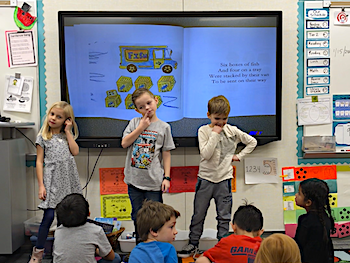SUBJECTS
GRADE
Show Results
Penguin Place Value Emotions
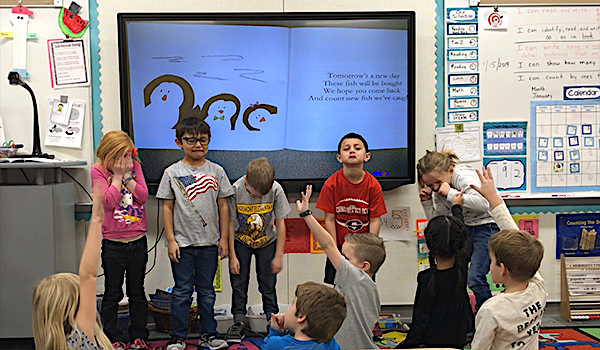
Lesson Summary
- Read the book Penguin Place Value.
- Show character emotions with facial expressions and body gestures.
Lesson Plan and Procedure
Lesson Key Facts
- Grade(s): K, 1, 2
- Subject(s): Drama, English Language Arts, Math
- Duration of lesson: 30-45 minutes
- Author(s): Emily Soderborg
Teacher: Look at this book. I wonder if we can discover some things about the book by looking at the title, Penguin Place Value: A Math Adventure. Just from the title, what do you think this book is going to be about?
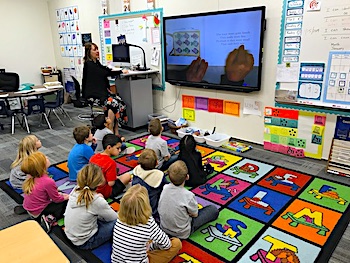
Teacher: In the title is the term place value. Place value means the value or amount a digit is worth, depending on its place within a number. A digit is any of the symbols 0, 1, 2, 3, 4, 5, 6, 7, 8, or 9.
Teacher: As we read this book, pay attention to the patterns of numbers. Look for “ones” and “tens”
Read Penguin Place Value to the students and share the illustrations.
Showing Emotions
Teacher: Students, each of us expresses emotions. The word emotion means how we feel. If I say, “What emotion are you feeling today?” you might say, “I’m feeling happy, mad, tired, or hungry.” Tell me some different emotions we feel.
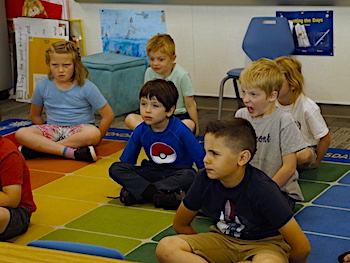
Teacher: We can use different parts of our bodies to express emotion. Today I want us to practice showing emotion with just our faces. Sit on your hands, and let’s warm up our faces. Move your eyes all around. Wiggle your nose, then your cheeks. Stretch your mouth out wide. Bring your mouth in small. Okay, I think we’re ready. With just your face, how would you express “happy”? Look at those eyes. They are bright and open. I see large smiles. Remember to show me with just your face, not your voice. How would you express “angry”? I see eyes narrowed and mouths pinched. Your eyebrows are furrowed. Show me “bored.” How about “nervous”?
Help students experience a variety of emotions they can portray with just their faces.
Point to one picture of a face showing emotion, from either real pictures of faces (https://www.lakenheath.af.mil/News/Photos/igphoto/2001470361/ ) or cartoon pictures of faces (https://www.tes.com/teaching-resource/character-emotions-charts-11776963). If cartoon pictures are used, cover the word describing the emotion.
Teacher: Look at this picture of a face. . . . What emotion is this person showing? What’s your guess?
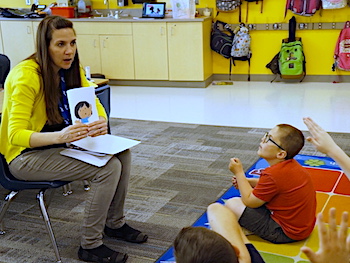
Teacher: Let’s show some emotions again, but with our whole bodies this time. Think about what your hands are going to do. And your legs. How about your shoulders?
Show me “surprised.” (Pause and scan the room.) I see lots of people using their hands. How about your feet? When you are surprised, what do they do? How could you show “confused”? What do your shoulders do? Think about how you can use your whole body to show the emotion of "sad," and then show me.
Portraying Character Emotions
Teacher: In the book, the illustrations didn’t really show us different emotions for the penguins. I couldn’t tell very well what these penguins were thinking or feeling. We can understand others better when we can recognize their emotions. The penguins in this book have the possibility of expressing lots of different emotions. Today we’ll go through the scenes in the book again and imagine some different emotions they might be feeling.
First Scene: Family of Penguins (first page of the story text)
Model thinking out loud; then have students show emotions all together as a class.

Teacher: I’m going to pick one emotion and think of a reason why that emotion fits with a character on the page. If I need ideas for emotions to try, I might look at the pictures of faces we looked at earlier. I’m going to show you with my whole body the emotion I think the penguin is feeling and then tell you why I think that emotion fits the character.
Model several options for students, so they see that there isn’t just one right answer. Possible ideas could include the following:
- “Excited. . . . I get to spend the day with my family.”
- “Satisfied. . . . Being with my family, I feel important and know what I am doing.”
- “Uncomfortable. . . . It’s really cold here. That makes me uncomfortable, so I want to huddle closer to my family to stay warm.”
Teacher: Now, students, show me with your whole penguin bodies the emotion “excited.” Remember to keep your voices silent and just show me with your bodies. Show me “satisfied.” Show me “uncomfortable.”
Second Scene: Catching Fish and Putting On Trays (second and third pages of story text)
Turn to these pages of the book. This time the students will show emotions all together as a class, without the teacher modeling first.

Have students turn to a partner. One student in each partnership shows their emotions to the partner and then describes why that emotion might be on that page. Switch and have the other person show his or her emotion and then explain why the student picked that emotion. After both partners have shown emotions, have a few students share the emotions they showed and explain why they selected those emotions.
Possible ideas to prompt students if they need additional ideas could include these:
- “Impatient. . . . It’s hard work catching fish. I want to eat some of these fish right now, rather than having to wait.”
- “Frustrated. . . . Why are these trays so small? It makes us have to work even harder.”
- “Grateful. . . . I’m so glad I have this handy tray here. It means I don’t have to get up and walk over to the yellow boxes every time I catch a single fish.”
- “Surprised. . . . I can’t believe I actually caught a fish. This is my first one!”
Remember to side coach to help students go beyond their initial way of showing the emotion. Can they use their faces more? How do their bodies show that emotion? For example, "We can show ‘mad’ a lot in our faces, but what about in our eyes, and our hands, and the way we walk?”
Deciding Emotions as Small Groups
Teacher: I’m going to divide us into three groups. I’ll give each group a picture from the book to look at. Together, decide on one emotion a character from that page might express. I’ll give you a few minutes to practice ways to show that emotion and select a reason why that emotion might be found on that page. As a group, you are going to show the emotion to the other two groups, and they are going to guess what emotion you are showing. Remember to use your whole bodies, not just your faces, to show the emotion. But your voices need to stay silent.
Divide the students into three groups, and give them five minutes to work. Make sure to have a copy of the character emotions chart displayed to prompt ideas as needed.
Third Scene: Moving Fish to Boxes and Storing on Ice (fourth and fifth pages of the story text)
 When you break into groups, have one group do this scene.
When you break into groups, have one group do this scene.
Possible ideas for prompts:
- “Disgusted. . . . I can’t believe I have to touch these slimy fish again.”
- “Focused. . . . I really have to pay attention, to make sure I put exactly ten fish in each box.”
- “Tired. . . . I have been catching fish all day, and now I have to move them into boxes. I’m ready for a break.”
Fourth Scene: Figuring Out How Many Fish were Caught (sixth, seventh, and eighth pages of the story text)
When you break into groups, have the second group do this scene.
Possible ideas for prompts:
- “Hopeful. . . . Maybe with all the money we make selling these fish, I can get the new toy I have been wanting.”
- “Confused. . . . What was I trying to figure out again?”
- “Confident. . . . Because we packed ten fish in each yellow box, I know exactly how many fish we have caught!”
- “Disappointed. . . . I thought I caught a lot more fish than that.”
Fifth Scene: Come Back Tomorrow (ninth page of the story text)
When you break into groups, have the third group do this scene.
Possible ideas for prompts:
- “Sincere. . . . I am inviting you because I really do want to see you again.”
- “Hesitant/nervous. . . . Is this new friend going to come back tomorrow?”
- “Happy. . . . It makes me happy to share my day’s adventures with you!”
Bring the class back together on the rug. Have each group perform the emotions from their scene. Have the other groups guess what emotion they were showing. Have each group explain why they picked that emotion.
Teacher: Think back. What was your favorite emotion you got to show today? Why?
Listen to a few student responses.
Teacher: What emotions did you feel last time, when you played “Johnny Works with One Hammer” on the drum and glockenspiel? Show me with your face and entire body one of those emotions. How would you feel about catching and counting fish like the penguins? Show me that emotion with your body. What emotions have you felt doing math the way we have done it the past two days?
Learning Objectives
- Understand that the two digits of a two-digit number represent amounts of tens and ones.
- Deepen understanding of characters through gestures and facial expressions.
- Describe characters in a book.
Utah State Board of Education Standards
This lesson can be used to meet standards in many grades and subject areas. We will highlight one grade’s standards to give an example of application.
Grade 1 Mathematics
Standard 1.MP.4: Model with mathematics. Identify the mathematical elements of a situation and create a mathematical model that shows the relationships among them. Identify important quantities in a contextual situation, use mathematical models to show the relationships of those quantities, analyze the relationships, and draw conclusions. Models may be verbal, contextual, visual, symbolic, or physical.
Standard 1.MP.7: Look for and make use of structure. Recognize and apply the structures of mathematics such as patterns, place value, the properties of operations, or the flexibility of numbers. See complicated things as single objects or as being composed of several objects.
Standard 1.NBT.2: Understand that the two digits of a two-digit number represent amounts of tens and ones. Understand the following as special cases:
10 can be thought of as a bundle of ten ones, called a "ten."
The numbers from 11 to 19 are composed of a ten and one, two, three, four, five, six, seven, eight, or nine ones.
The numbers 10, 20, 30, 40, 50, 60, 70, 80, 90 refer to one, two, three, four, five, six, seven, eight, or nine tens (and 0 ones).
Grade 1 Drama
Standard 1.T.CR.5: Create character through imagination, physical movement, gesture, sound and/or speech and facial expression.
Standard 1.T.P.4: Use body to communicate meaning through space, shape, energy, and gesture.
Standard 1.T.CO.2: Identify connections to other content areas in dramatic play or guided drama experiences.
Grade 1 English Language Arts
Standard 1.R.7: Describe characters, settings, and important events in a story (RL)
Equipment and Materials Needed
- Stone, Kathleen L. Penguin Place Value: A Math Adventure Place of Publication: n.p., 2014. (two copies, one for reading and one to pull apart so each group can use the illustrations for scenes three, four, and five [penguin putting boxes in the igloo, boxes stacked by the van, and the family of penguins waving on the last page])
- Pictures of faces showing various emotions: https://www.lakenheath.af.mil/News/Photos/igphoto/2001470361/
- Character emotions chart (projected or printed as an 11x17): https://www.tes.com/teaching-resource/character-emotions-charts-11776963
Additional Resources
- This lesson is part of a unit using the arts to teach place value. The lessons can be found on the BYU ARTS Partnership website. The titles include the following:
- These ideas could be transferred to other books that teach about place value. Some good books include the following:
- Sir Cumference and All the King’s Tens by Cindy Neuschwander (this would be my preference for second-grade classes)
- A Place for Zero by Angeline Sparagna LoPresti
- Zero the Hero by Joan Holub
- Earth Day-Hooray! by Stuart Murphy
- Several ideas for this lesson were adapted from a lesson shared by the Center for Learning in the Arts and Sciences. This resource has multiple lessons that focus on literacy through the arts using theater, dance, and puppetry, for grades K–2: https://sites.uci.edu/class/first-grade/theater-first-grade/grade-1-theater-lesson-1/
Image References
Image 1: Lisa Garner.
Image 2: Emily Soderborg.
Images 3–6: Dianne Amesse.
Image 7–8: Lisa Garner.

www.education.byu.edu/arts/lessons
 Download
Download